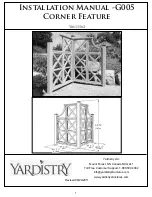
c. p
ull
r
od
A
djuStMent
The pull rod (Figure 1, #13) is a turnbuckle, with
a right-hand thread at the crank and a
left-hand thread at the flywheel connection.
Slow close the mechanism as described in
Ch 5 Mechanical Checks and Adjustments
. As the flywheel
rotates the slotted link pulls the closing toggle
pin over-center so that the spacers on the end
of the pin are resting on the mechanism frame.
In this position, the slotted link should be in
contact with the closing toggle pin.
If the spacers are not against the frame, the
toggle links must be tapped firmly downward
so that they rest against the frame.
CAUTION
If the slotted links do not bottom on the toggle
pin, readjustment of the pull rod length is
required. To adjust the pull rod, loosen the nuts
on each end and adjust the rod length until the
slotted link bottoms against the toggle pin.
Note:
Before making adjustments to the
pull rod the overtravel stop bolts
(Figure 2, #27) should be backed out
of the horizontal connecting bar two
turns.
Increase the rod length by backing off about 1/4
turn so that the slotted links are just free of the
pin and can move slightly from side to side.
In this position the slotted links (Figure 1, #17)
should have no apparent clearance to the pin
in the close toggle (Figure 2, #51) but should be
capable of being moved axially along the pin
by firm finger pressure. Tighten the pull rod
lock nuts to 30-35 ft-lbs. of torque.
If the pull rod is too short, i.e., slotted link is
too tight against the pin in the closed toggle,
the pin may be bent and require replacement.
CAUTION
d. t
rIp
l
AtcH
c
leArAnce
Refer to items 5 & 8 in Figure 3 (a). Charge and
gag the close spring as described in
steps 1 & 2
of
Ch 5 Mechanical Checks and Adjustments
. With the ground
and test device open, determine the trip latch
clearance by depressing the trip roller against
the latch face from its spring-reset position. If
no apparent motion exists, depress the manual
trip push button and see if the trip roller
rotates.
The latch clearance should be set between .005
and .040 inch. The trip roller must not rotate
when the latch is moved by the manual push
button. The clearance may be estimated by
pressing the roller down against the latch.
To adjust, loosen the locking nut
(Figure 2, #53) holding the stop bolt to the
horizontal connecting bar, and then unscrew
the stop bolt to decrease latch clearance while
pushing the manual trip push button in and
out until the trip roller just starts to turn.
Note:
Before making adjustments to the
trip latch clearance the overtravel
adjustable bolts (Figure 7, l) should
be backed out of the horizontal
connecting bar two turns.
Screw in the adjusting bolt until the roller no
longer turns. Torque the lock nut to
55 ft-lbs. while holding the adjusting screw.
This sets latch clearance at a minimum and
any mechanism wear will tend to increase
the clearance. When 0.060 inch clearance is
reached readjustment will be required.
Powered by Safety
®
17
Mechanical Checks and Adjustments
01.4IB.50100











































